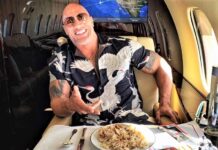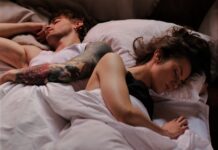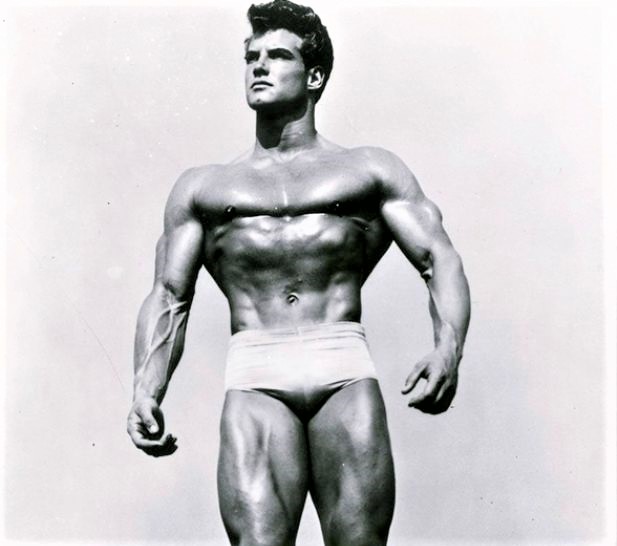There can only be one—the most aesthetic male physique of all time. Seven decades after he last posed on a dais, Steve Reeves is still champ. In fact, as a reaction against the modern bigger-is-better ethos, he’s only solidified his status. Today, the original Hercules is the archetype for the modern classic physique. Long ago and with only simple tools and food, Steve Reeves (1926-2000) constructed one of history’s most perfect bodies. How did he do it, and what lessons can you apply to your workouts today?
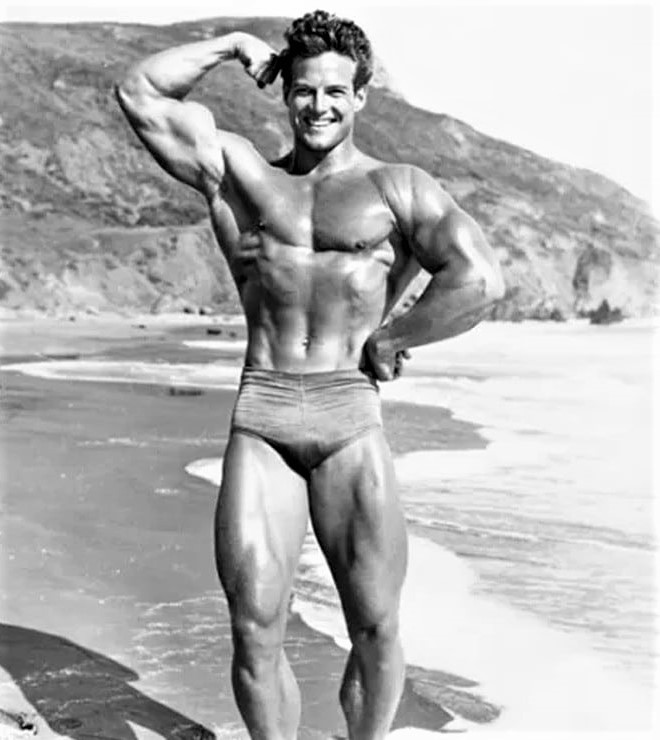
THE MOST CLASSIC PHYSIQUE
He seemed like something conjured up in an artist’s workshop. Joe Weider effused, “Steve Reeves was the male ideal of physical perfection.” After witnessing the 21-year-old Reeves shortly before he won the 1947 Mr. America, a writer in Your Physique magazine raved, “I, personally, proclaim him to be the finest specimen of American manhood I have ever seen in a kid of his years. He hasn’t a single weak spot in his make-up….He seemed from out of this world, just as though a super-man had suddenly appeared on a pedestal.”
When he won the 1950 Mr. Universe over future legend Reg Park, Reeves was only 24, but the 6’1”, 220-pounder had reached the pinnacle of bodybuilding, competitively and aesthetically. His face was as perfectly chiseled as his physique, and Hollywood noticed. However, despite a few small movie and TV roles, American producers never figured out what to do with someone so distractingly handsome and, by pre-steroid standards, colossal. Maybe he could only play a god. In 1957, Reeves traveled to Rome to star in what he thought would be just some Italian kid’s movie. But Hercules was a smash hit in Europe, and, in 1959, in America, too, launching its star to international fame.
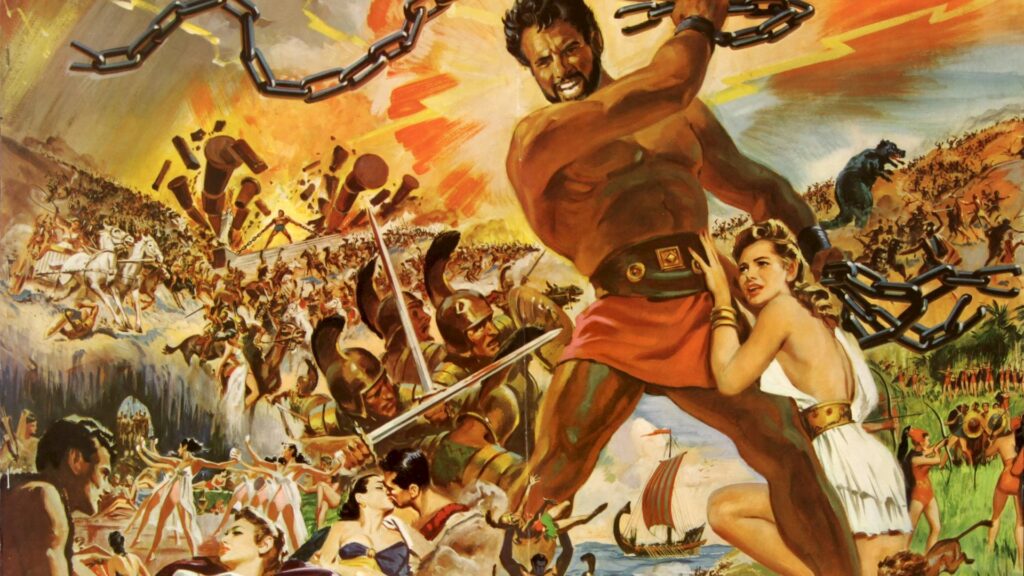
A successful sequel quickly followed, and so did a deluge of Italian-made, sword-and-sandal flicks, some starring Reeves, some starring other musclemen. Via big screens, Steve Reeves became bodybuilding’s worldwide ambassador, even if few fans ever heard his real voice. (In the Italian-made movies, his voice was dubbed.) A generation of boys, including a young Arnold Schwarzenegger, came of age wanting to be the son of Zeus, and many of them spent their allowances on barbells. In the late ’60s, Steve Reeves retired with his wife to their Southern California ranch. Though he died in 2000, he is still celebrated for what many regard as the prototypical muscular physique.
What follows are the dozen principles that turned a skinny teenager into the world’s best bodybuilder, a cinematic superstar, and an enduring legend.
THE EVERYTHING WORKOUT
“When you work your whole body in each workout, it forces you to think about symmetry. Your focus is always on the whole and not the parts,” Steve Reeves said. In the ’40s and ’50s when the future Hercules was expanding, he hit everything every time, as was the norm then. It wasn’t circuit training. Instead, he usually did three sets of an exercise before moving to the next one. Nevertheless, he went fast, resting only 45 seconds between sets. In the following typical Reeves full-body workout, he progresses through 15 exercises.
Upright Row 3 sets x 8-12 reps
Bench Press 3 sets x 8-12 reps
One-arm Dumbbell Row 3 sets x 8-12 reps
Dumbbell Side Lateral 3 sets x 8-12 reps
Standing Military Press 3 sets x 8-12 reps
Pushdown 3 sets x 8-12 reps
Barbell Curl 3 sets x 8-12 reps
Dumbbell Incline Curl 3 sets x 8-12 reps
Squat 3 sets x 8-12 reps
Barbell Pullover 3 sets x 8-12 reps
Breathing Squat 1 set x 20 reps
superset with
Breathing Pullover 1 set x 20 reps
Deadlift 2 sets x 8-12 reps
Good Morning 2 sets x 8-12 reps
Leg Raise (3 x 10-15 reps) or Stomach Vacuum (3 x 20-30 seconds) or Incline Sit-Up (3 x 10-15 reps)
You’ll probably notice the things he didn’t do. Where are the leg curls? Did he train calves? Did he really do only three sets for chest and three for triceps? This is a sample routine. And the three, weekly, full-body routines gave him the space to switch things up. He would regularly swap in other exercises. (For example, here’s his routine for the 1947 Mr. America with leg curls and calf presses and six sets for chest. That article states: “He has followed many programs during his five years of exercising…”) But there is a limit to how many exercises you can devote your full focus and intensity to in one full-body workout.
In the ’60s, split routines superseded full-body sessions. Still, an everything workout remains a valid way to train when you can rarely make it to the gym. One intense, everything assault can hold you over for a week. Keep your total sets to 40 or fewer. This means you won’t have the luxury of exhausting muscles with a dozen sets of isolation exercises. Instead, focus on compound exercises like deadlifts, squats, and dips, and push all sets to failure.
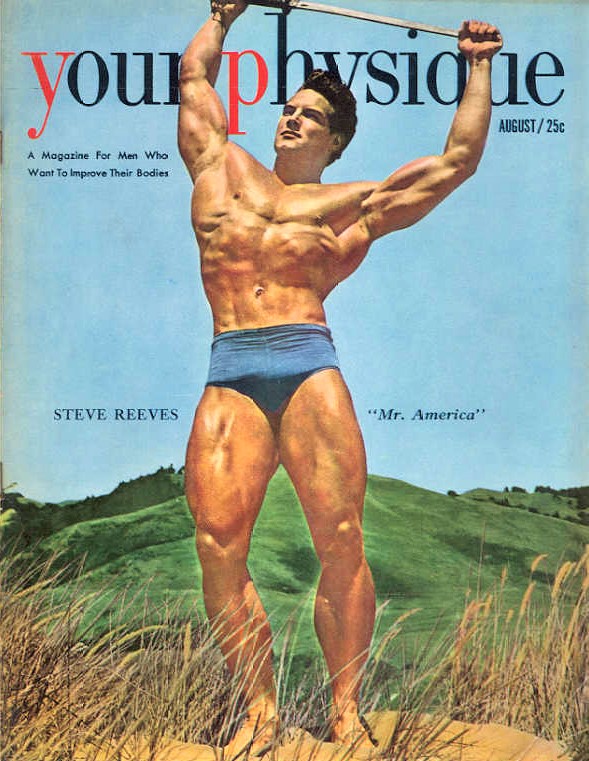
48 HOURS OFF
Steve Reeves scheduled his full-body sessions for Mondays, Wednesdays, and Fridays. In our routine below, we modernize his “non-split” and divide the body into three distinct routines. Stick to a similar workload per session (30-40 sets) and maintain his pattern of resting at least 48 hours between trips to the gym.
PERFECT FORM
In the opinion of cinema’s Hercules, cheating was not a virtue. Sets consisted of flawless reps with a cadence of two seconds up and three seconds down.
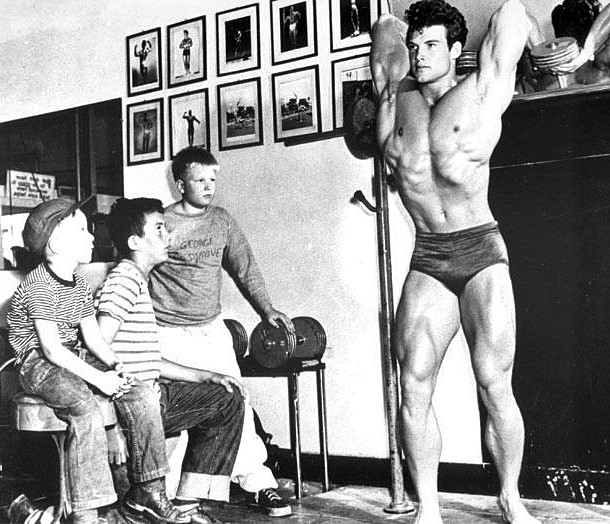
MODERATE REPS
Most sets were kept in the ideal growth range of 8-12 reps. He occasionally went higher, but he almost never went lower.
STRENGTH PROGRESSION
One training tenet that preceded even Steve Reeves, who was born 96 years ago, is progressive overload, which is a fancy way of saying: strive to get stronger. The 1950 Mr. Universe didn’t push his sets beyond failure with various techniques (most of which weren’t even named yet), but he was fixated on racking up more reps in the 8-12 range. When he could get 13 reps, he upped the weight the next time.
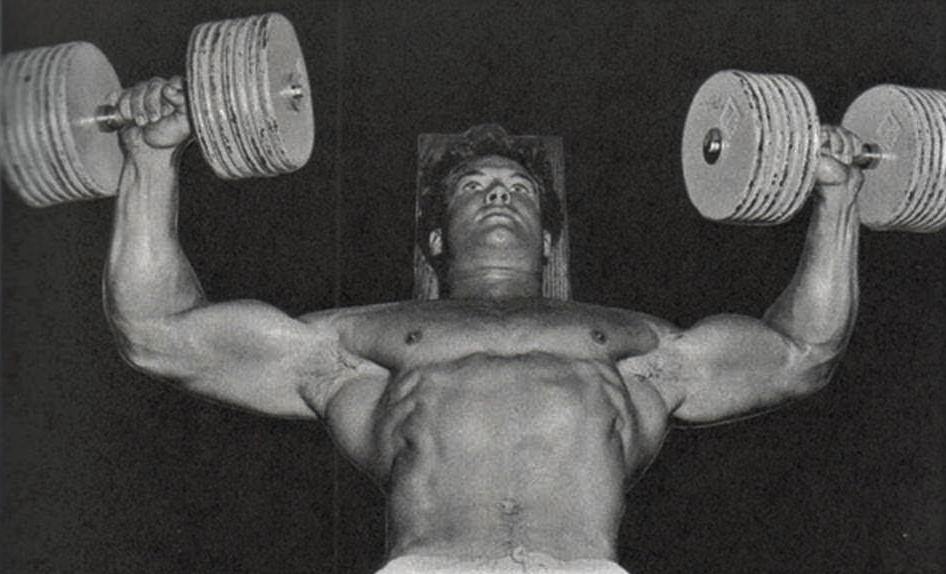
ALTERNATE ANTAGONISTICS
Working his whole body in one routine, Steve Reeves couldn’t help but stress one diverse bodypart after another. However, he still arranged exercises so that one movement often followed its antagonist, such as rows (pulling for back) after bench presses (pushing for chest). In this way, an exercise could warm and stretch the next area trained. Our routine also pairs up antagonists: chest with back, biceps with triceps, and quadriceps with hamstrings.
MOSTLY FREE WEIGHTS
Teenage Steve Reeves began creating his masterpiece with only dumbbells and a barbell in the garage of his stepfather’s house in Oakland, California; and, even when he found his way into the rare gym 75 years ago the most sophisticated machine was a primitive, plate-loaded, cable-and-pulley device. So, Reeves constructed one of the greatest physiques of all-time almost entirely with free-weight and bodyweight lifts.
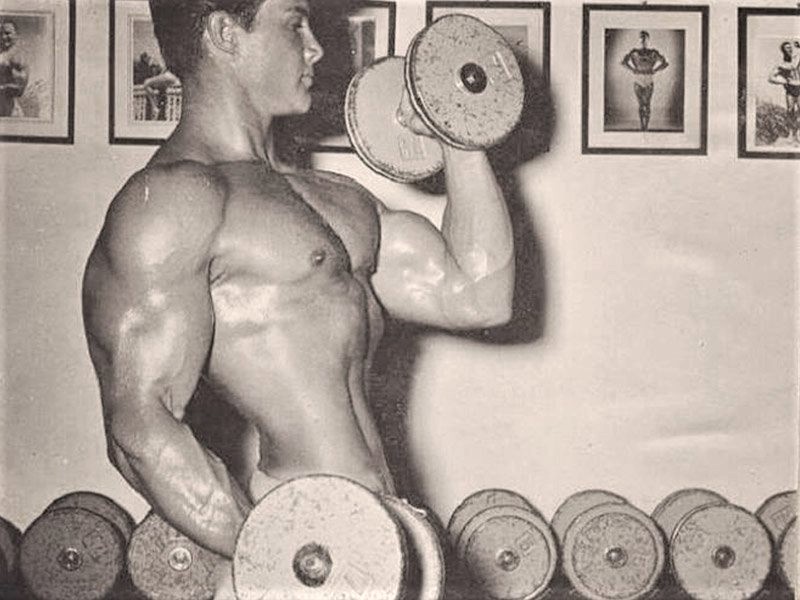
LIFT LARGE LATE
Steve Reeves saved his most taxing exercises, squats and deadlifts, for the homestretch of his routine. This is an unorthodox routine order, but it did have three advantages. First, he was thoroughly warmed up. Second, he could put his all into those demanding lifts and not have that effort diminish his strength and energy reserves for other exercises. Third, along with the fact that Reeves did at least eight reps, the preceding exercises drained some of his strength, so he could go lighter while still giving his all, therefore reducing injury risks.
STAND UP
Most of the time, when Steve Reeves had a choice between hoisting a weight seated or standing, he stood. Doing so engaged his lower back, abs, and legs as stabilizers on lifts like military presses and overhead triceps extensions, thereby incorporating as many muscles as possible. This was fundamental to Reeves treating his body as a single, flowing work of art and not a collection of parts.
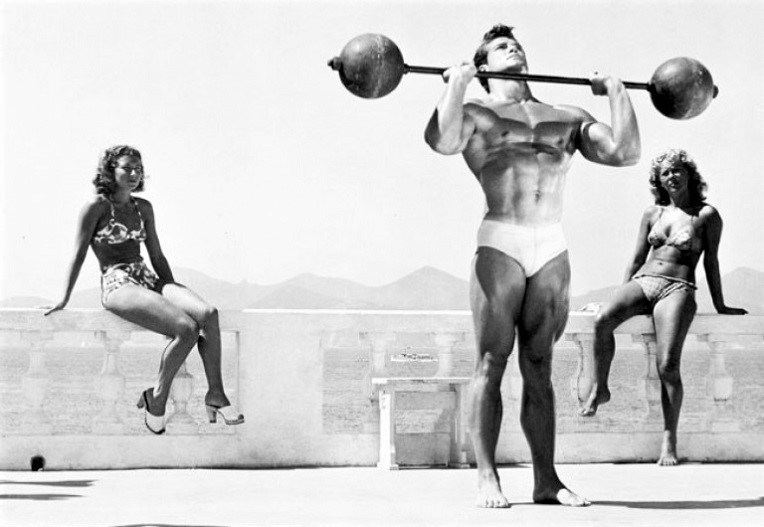
SCULPT THE SILHOUETTE
Steve Reeves was forever focused on his physique’s silhouette: wide shoulders, slim waistline, proportionate development. At the 1947 Mr. America, his arm (18″), calf (17¾”), and neck (17½”), measured nearly the same, which was considered perfect balance.
✷ In the above sample routine, cinema’s Hercules did more sets for shoulders (upright rows, military presses, side laterals) than any other bodypart. This was a point of emphasis to give him a wide-shoudered silhouette, as opposed to emphasizing ever-thicker pecs and ever-wider lats, which can detract from the shoulders.
✷ One of the elements of his workouts—ribcage expansion by supersetting pullovers and high-rep “breathing squats”—was misguided. Don’t waste time trying to alter your skeletal structure. You can’t.
✷ Another component of his routine—the stomach vacuum (pulling your waist in as far as possible and holding for 20-60 seconds)—is a relic that deserves to be resurrected. Like planking, it works the transverse abdominis (inner ab wall) and teaches you to hold your waist in.
✷ Reeves avoided weighted oblique exercises for fear of widening his waist.
✷ He did no shrugs, believing a sloping trapezius would make his shoulders appear narrower (his traps, though, were worked with upright rows and deadlifts).
✷ Reeves trained his neck, as was common at mid-century but rare for bodybuilders today. Add neck exercises to your routine to improve your arms-calves-neck balance and appear Herculean even in a suit and tie.
POWER WALKING
As was the norm way, way back in the day, Steve Reeves did only occasional cardio (beach jogging) during the years when he flexed on bodybuilding stages or movie sets. However, in the 1980s when Reeves was in his fifties and prioritized fitness, he popularized power walking. This is a rapid jaunt performed with long strides and pendulum-like arm swings, ideally while holding light dumbbells. With plenty of room to roam on his ranch, Reeves went for such low-impact, moderate-intensity marches year-round. Think of any outdoor legwork—including hiking, wind sprints, and jogging—as Hercules-style cardio.
STAY LEAN
Steve Reeves’ diet was a product of a time when much less was known about sports nutrition. A greater emphasis on protein and frequent, small meals only emerged in bodybuilding circles in the 1950s in conjunction with the first protein powders. Before then, Reeves ate three meals daily, with a 60-20-20 ratio of carbohydrates, protein, and fat, and with lots of fruit. He kept his calories relatively low and correctly avoided table sugar and white floor.
As a consequence of his diet, Reeves never attained the peeled conditioning of modern champs. But he also never bulked up and blew out his waist, chasing ever larger numbers on the scales like too many modern champs. Allow yourself to get too soft and you’ll reverse-engineer what should be a work of sculpture into a shapeless block. This can potentially stretch out your abdominal wall, and it will only hurt your ability to remain focused on improving your silhouette and proportions—like Steve Reeves, so long ago.
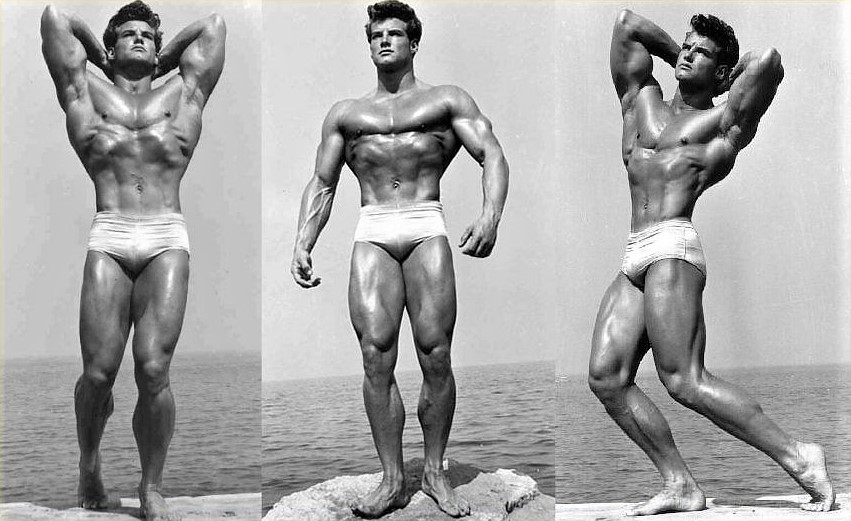
THE STEVE REEVES WORKOUT
MONDAY: CHEST/BACK/ABS
Barbell Row — 4 sets x 8-12 reps
Bench Press — 4 set x 8-12 reps
One-arm Dumbbell Row — 4 sets x 8-12 reps
Incline Dumbbell Press — 4 sets x 8-12 reps
Front Pulldown — 4 sets x 8-12 reps
Incline Dumbbell Flye — 4 sets x 8-12 reps
Dumbbell Pullover — 3 sets x 8-12 reps
Deadlift — 2 sets x 8-12 reps
Good Morning — 2 sets x 8-12 reps
Hanging Leg Raise — 4 sets x 10-15 reps
WEDNESDAY: SHOULDERS/ARMS/ABS
Upright Row — 3 sets x 8-12 reps
Standing Military Press — 4 sets x 8-12 reps
Dumbbell Side Lateral — 4 sets x 8-12 reps
Dumbbell Rear Lateral — 3 sets x 8-12 reps
Pushdown — 3 sets x 8-12 reps
Incline Dumbbell Curl — 3 sets x 8-12 reps
Overhead Triceps Extension — 3 sets x 8-12 reps
Barbell Curl — 3 sets x 8-12 reps
Dip — 3 sets x 8-12 reps
Concentration Curl — 3 sets x 8-12 reps
Barbell Wrist Curl — 4 sets x 10-15 reps
Stomach Vacuum — 4 sets x 20-40 seconds
FRIDAY: LEGS/NECK/ABS
Leg Extension — 4 sets x 10-12 reps
Hack Squat — 3 sets x 8-12 reps
Lying Leg Curl — 4 sets x 8-12 reps
Front Squat — 3 sets x 8-12 reps
Stiff-leg Deadlift — 4 sets x 8-12 reps
Squat — 4 sets x 8-12 reps
Standing Calf Raise — 4 sets x 10-15 reps
Seated Calf Raise — 4 sets x 10-15 reps
Neck Raises: Front, Rear, Sides — 2 sets (each direction) x 10-15
* Incline Curl-Up — 4 sets x 10-15 reps
* Steve Reeves did incline sit-ups, but we don’t recommend that exercise. Do incline curl-ups instead.
Related: Serge Nubret and Pump Training















